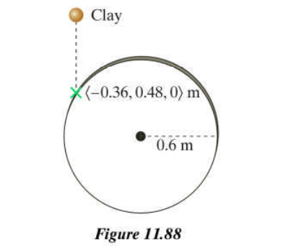A rotating uniform-density disk of radius is mounted in the vertical plane, as shown in Figure 11.88.The axle is held up by supports that are not shown, and the disk is free to rotate on the nearly frictionless axle. The disk has mass A lump of clay with massfalls and sticks to the outer edge of the wheel at the location relative to an origin at the centre of the axle. Just before the impact the clay has speed and the disk is rotating clockwise with angular speed

(a) Just before the impact, what is the angular momentum (magnitude and direction) of the combined system of wheel plus clay about the center(As usual,is to the right,is up, andis out of the screen, toward you.) (b) Just after the impact, what is the angular momentum (magnitude and direction) of the combined system of wheel plus clay about the center(c) Just after the impact, what is the angular velocity (magnitude and direction) of the wheel? (d) Qualitatively, what happens to the linear momentum of the combined system? Why? (A) There is no change because linear momentum is always conserved. (B) Some of the linear momentum is changed into angular momentum. (C) Some of the linear momentum is changed into energy. (D) The downward linear momentum decreases because the axle exerts an upward force.






